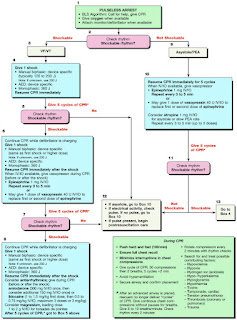When I looked through the issue of American Heart Journal that has that much-hyped study, though, I found another paper, one that appears more more useful. What's more, you can start using the results today, and could plausibly save a whole lot more lives (or at least myocardium) than with the "cardiac cocktail."
 |
| Ironically, the evidence is better for this cocktail in cardiac disease. |
So, when do you decide to get an ECG on a patient in the field? If they have chest pain, sure, but probably not in all chest pain. And you're probably sharp enough to grab an ECG in the old guy with new nausea or dypsnea. But are you missing some STEMIs? Are you getting too many ECGs, and wasting your time? Someone outta do a study.
Well, Glickman et al. did, and I'll boil down the results that you can use on your next shift.
The study is called "Development and validation of a prioritization rule for obtaining an immediate 12-lead electrocardiogram in the emergency department to identify ST-elevation myocardial infarction." You really don't need to download the whole article, unless you have a deep interest in binary recursive partitioning.
 |
| A very, very deep interest in binary recursive partitioning... |
The problem in emergency departments, just like in the field, is that a lot of STEMI patients do not show up with the classic chest pain symptoms. However, we want to identify all these STEMIs, but we also don't think we should get an ECG on everyone - it would just slow everything down. You also want a rule that is straightforward enough for a range of "non-physicians;" RNs, techs, and medics. (That being said, the results were very instructive for this physician.)
The researchers used a database of patients who came to a ED in North Carolina in 2007 and 2008, and looked at two things: who was diagnosed with a STEMI, and what the triage note listed as the chief complaint.
Funny: they used a computer program to search the triage notes for chief complaints, and called it the Emergency Medicine Text Processor (EMT-P).
 |
| A computerized EMT-P. ICWUDT. |
1. Chest pain is less common in older folks with STEMI.
This is already well-known, but they have a good pair of graphs that make the point clear. Age has a huge impact on the predominant symptom that people feel with a STEMI.
There is a small difference between men and women, but it's the age-effect that is so evident here. For example, women under 50 years of age have chest pain as their chief symptom about 85% of the time, while men over the age of 70 only note chest pain around 70% of the time. In other words, chest pain can be more common in women if you look at different age groups.
2. Think: ≥ 30, ≥ 50, and ≥ 80 years old.
When they fed all the data through C3P/EMT-P, they came up with a rule for deciding if you should get an ECG, based just on the age and chief complaint. They broke it down by 3 age groups, as noted above:
I want to emphasize the last bit there - this is a rule designed to assist non-physicians in screening a large number of patients rapidly, but it is constructed to supplement clinical judgment, not replace it.
Another way I might phrase the rule is:
- Anybody over 30 y.o. with chest pain gets an ECG,
- Anybody over 50 y.o with chest, head, and upper extremity complaints,
- Anybody over 80 y.o. with any torso complaints (except maybe isolated diarrhea...)
So, who were these 8% of STEMIs whom the rule would miss?
Who gets missed by this rule?
Again, a helpful diagram:
- It misses younger patients, even the ones with chest pain.
- It misses the young-ish patients with dyspnea.
- It misses the 50-79 year-olds with GI presentations.
- It misses the > 70 crowd that presents with... fever?!
The Bottom Line
One way that EMS can save lives is to identify STEMI patients in the field, followed by proper triage and notification. But you can only identify a STEMI if you get an ECG. This paper shows us how wide a net we have to cast in order to catch most of them.
Use the decision rule to prompt you or your partner to do more ECGs. And even when the rule doesn't necessarily call for a 12-lead, listen to your gut and follow your clinical suspicion.
























